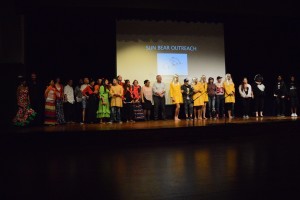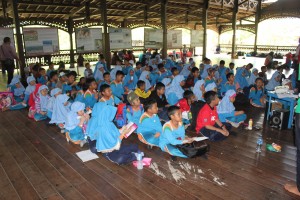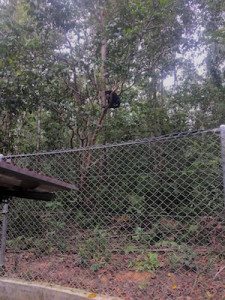Between August 2011 and September 2014, Patrick Rouxel, founder of Sun Bear Outreach, followed the rehabilitation to life in the wild of 3 orphan sun bear cubs. Then in 2014/2015, he helped coordinate the rehabilitation of another 3 cubs. These were carried out in the National Park of Tanjung Puting, Central Kalimantan, Indonesia with the collaboration of the Orangutan Foundation International (OFI).
All the cubs were brought to the forest and released in a soft and gradual way commonly known as the ‘walk-release method’ established by Dr Gabriella Fredriksson, co-chair of the IUCN Sun Bear expert team. In the wild, cubs follow their mother until they are about 2 years old and which point they become independent and go off to establish their own territories. With Gabriella’s method, a person takes over the roll of the mother bear and stays in the forest with the cub until he becomes autonomous.
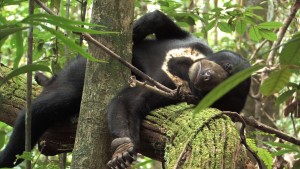
Bunbun at peace in the forest
A camp in the forest serves as base for both the carer and the cub. Every day, from dawn to dusk, the foster parent and the cub wonder in the forest. The cub, driven by hunger and a natural curiosity, will learn to forage for food and climb trees on his own. The simple presence of the a foster parent is enough to chase away any wild bear who could want to harm the cub, or a clouded leopard who could potentially prey on a sun bear cub. In the late afternoon, the foster parent and the cub return to camp where the cub is given supplementary food and locked in a den for the night (away from camp) until the next morning, when a new day of exploring and learning begins. And so on, day after day.
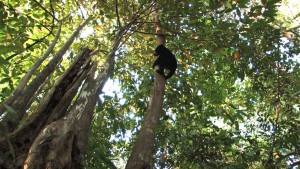
Bunbun exploring the forest
The first cub Patrick brought back to the forest was called Bunbun. She was about one year old when the reintroduction began. She had kept her instinctive fear of humans, which was a good thing and she quickly began going away on her own and disappearing for a day or two before showing up at camp again. Unfortunately, after just 3 months, she got in a fight (probably with another bear) and came back to camp with a broken leg. She was taken back to the OFI clinic where she received treatment and was kept in a small cage for 10 weeks, to allow the bone to heal. Then we brought her back to the forest, but she managed to escape from her transport cage upon arrival at the camp and she ran into the forest never to be seen again.
Six months later, Patrick brought two other cubs to the forest, Bernie and Wawang, who had also been taken captive at a young age from the wild, then confiscated by the local authorities and handed over to the Borneo Orangutan Survival Foundation (BOSF). To avoid losing the cubs in the forest like we had lost Bunbun, they were equipped with emitters placed in the abdominal cavity. This implant emits a radio wave that can be picked up by a receiver at a distance of approximately 300 m for about 3 years.
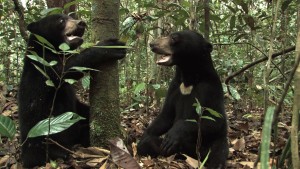
Bernie and Wawang in the forest
Unfortunately, after just 6 weeks, Bernie and Wawang ran off one late afternoon, beyond the limit of their tracking device, and spent their first night alone in the forest. The next morning, Wawang’s body was found, lifeless and covered in wounds from what looked like a fight with another bear. But Bernie was alive and she ended spending about 1 year and a half with Patrick in the forest, as she grew older and increasingly autonomous. We hope that she is still out there thriving as a free bear in her natural habitat.
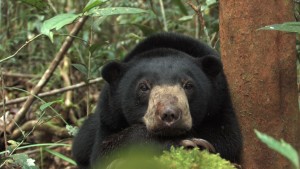
Wawang in the forest
After Bernie left to lead her own life, Patrick began the construction of a one hectare forest enclosure for 3 adult bears who could not go back to the wild, at the Care Centre of the Orangutan Foundation International (OFI). While doing this he participated in the coordination of the release of another 3 cubs: Ori, who sadly was brought back to the OFI Care Centre after 3 months in the forest because his carer abandoned the project, then Koko and Octa who unfortunately disappeared in the forest although they were still not fully autonomous. Despite the tracking devices, Koko and Octa they were never to be found again.
Since, Sun Bear Outreach has not participated in any other reintroductions of cubs to the wild, because we have focused our attention on building large forest enclosures for captive sun bears who cannot go back to the forest. But if the opportunity to release more sun bears to the wild presented itself and if the conditions were favourable, we would certainly try again, because despite the difficulty of the task, we believe that an attempt to a life in the wild is still better than a long life of captivity.
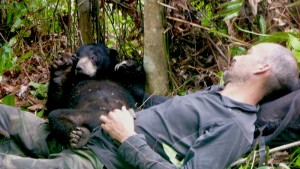
Bernie and Patrick in the forest

